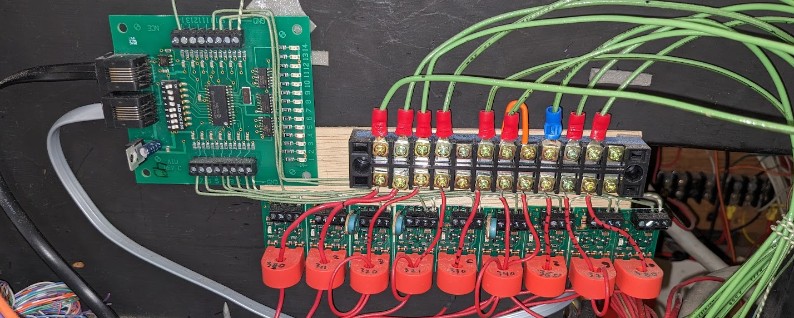The Randall Museum in San Francisco hosts a large HO-scale model model railroad. Created by the Golden Gate Model Railroad Club starting in 1961, the layout was donated to the Museum in 2015. Since then I have started automatizing trains running on the layout. I am also the model railroad maintainer. This blog describes various updates on the Randall project and I maintain a separate blog for all my electronics not directly related to Randall.
2023-05-01 - Adjusting the Mountain BD20 Sensors
Category RandallThe BD20 sensors on the mountain are being problematic for blocks B321, B340, and B370.
They sometimes “flicker” when the trains run, and do not detect the trains once they are stopped.
The issue has been going on for a while, and depends a lot on the type of automation train I’ve been running. When we started the automation, the passenger train had two Rapido engines in push-pull configuration, and I initially calibrated the sensors for that train. Then we had a set of “older” engines such as Athearn, etc, which triggered the sensors just fine. A few years ago I changed this for modern Walthers or Bachmann SD70s, and the sensor sensitivity was borderline at detecting them -- I’m guessing these engines just use less current than the older kind.
Conductor 1 doesn’t care. It only cares to detect the trains stopped at the station. Once they start their route, Conductor 1 just sends commands to the trains “blindy” whether they are properly detected or not.
Conductor 2 is a problem since the new design tries to be “smarter” and monitors the sensors all along their automated route, and it goes into error when the train is seen “missing”. So when an automated train stops for reversing and the sensor suddenly fails to detect the train, the automation thinks the train is gone and enters error mode.
BD20 configuration:
- B321 has resistor, 2 wire turns.
- B340 has resistor, 2 wire turns.
- B370 no resistor, 2 wire turns.
Current JMRI sensor debounce setup:
- Inactive delay = millis before reporting sensor as inactive (thus on→off delay)
- Active delay = millis before reporting sensor as active (thus off→on delay). This should be zero.
- B320 = inactive delay 750 ms, active delay 0 ms
- B321 = inactive delay 750 ms, active delay 0 ms
- B340 = inactive delay 2000 ms, active delay 0 ms
- B370 = inactive delay 750 ms, active delay 0 ms
In the case of B321, I note that the AIU LED does light up when the train is stopped, even though the sensor is reported as inactive in JMRI. I haven’t verified it, yet I’m guessing the LED turns on when the BD20 sinks current even though it may not be a voltage high enough to trigger the logic in the AIU.
I adjusted the B321 sensitivity’s resistor to provide detection when the freight train is on the track, even when stopped. I later tried the passenger train and it was still flickering a bit. I’ll need to make it even a bit more sensitive.
For B340, I had to adjust the resistor to the max sensitivity to work properly.
Unfortunately B370 doesn’t have a resistor on the BD20; I should add one so that I can enhance the sensitivity.


